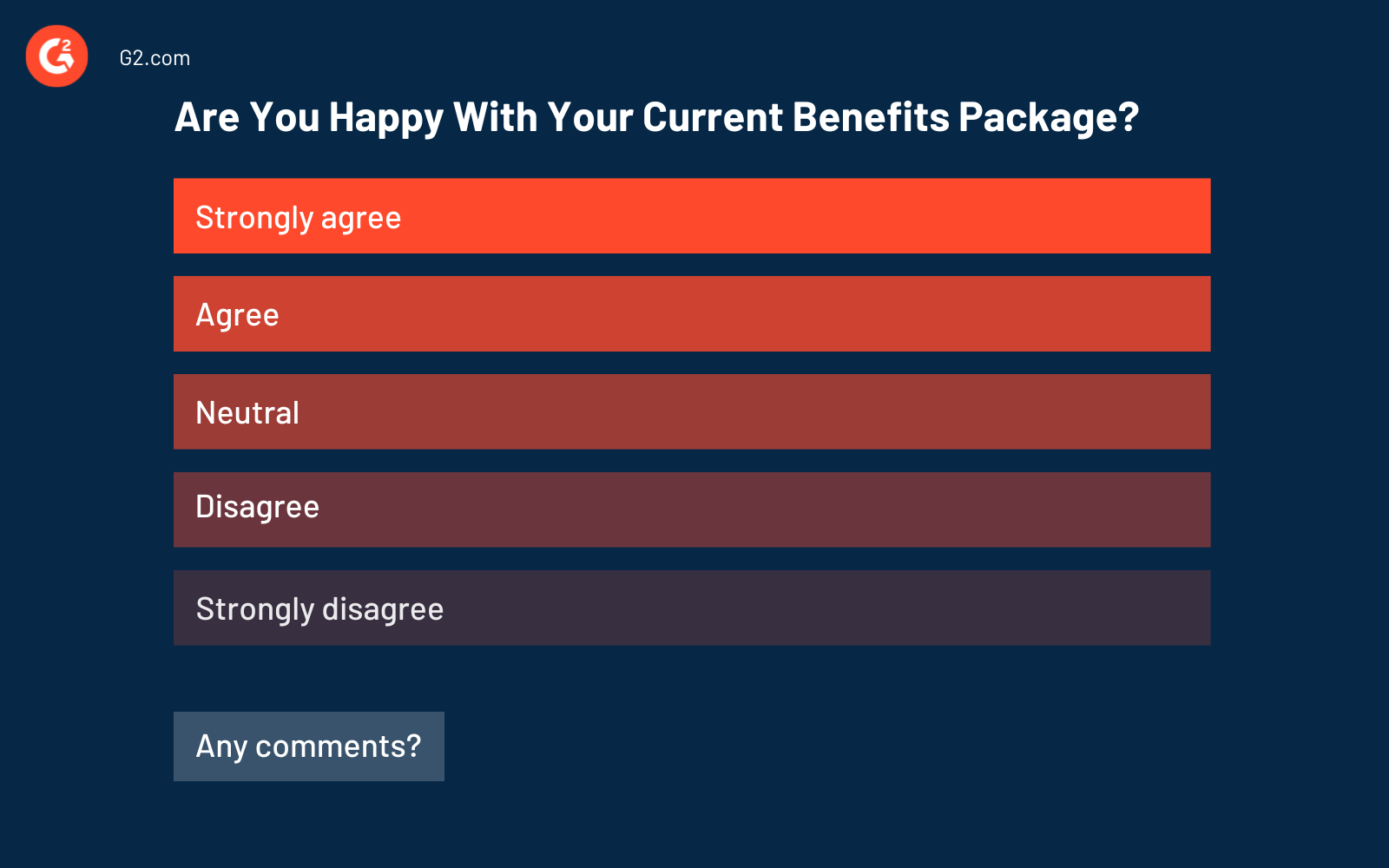What is an employee satisfaction survey?
An employee satisfaction survey, also known as a job satisfaction survey, is a tool used by human resources professionals to gauge the happiness and overall contentedness of their company's employees.
If you’ve never conducted an employee satisfaction survey before, consider investing in employee engagement software. It helps you monitor and track your employee satisfaction surveys and make the process less overwhelming.
Once you’ve conducted the survey, analyze the results to take the next steps toward improving the work environment.
In this article, we’ll review why employee satisfaction surveys are important, how you should go about conducting them, and questions for your next employee satisfaction survey.
Importance of employee satisfaction survey
Whether or not your employees are showing signs of unhappiness at work, you should routinely conduct an employee satisfaction survey. Most employers try to schedule employee satisfaction surveys annually and track the progress year over year.
There are plenty of reasons why you should measure employee satisfaction, the most alarming of which is declining satisfaction. Unhappy employees are more likely to seek new opportunities than those who are happy with their jobs.
The cost of high employee turnover can have long-term effects on your company if it goes unsolved. And if you think your employees are the exception to the rule, you may be shocked to learn the truth.
With all of this in mind, it’s more important than ever to ensure that your employees are happy with their jobs, and if they aren’t, here's how to improve the employee experience.
“To win in the marketplace, you must first win in the workplace.”
Doug Conant
CEO, Campbell's Soup
Want to learn more about Employee Engagement Software? Explore Employee Engagement products.
Benefits of employee satisfaction survey
Multiple studies have reported that good company culture drives an increase in revenue. And that's just one of the many benefits of sweetening the employee experience.
An employee satisfaction survey enables you to measure and improve the company culture and promote workplace productivity and accountability in the organization. Some other benefits of conducting a survey are:
- Boosted employee engagement. Who doesn't like to be heard? Surveys make employees feel heard and valued. Letting employees know that their opinions and experiences matter drives increased engagement and productivity.
- Better employee retention. It's a known fact that retention is better than acquisition, be it, customers or employees. Satisfied employees are less likely to leave the organization, reducing turnover costs.
- Improved decision-making. Data collected from the survey can provide valuable insights into multiple areas of improvement, such as workplace culture, career opportunities, and communication gaps. Working on the issues raised motivates employees and fosters company growth.
- Increased customer satisfaction. Happy employees, happier customers. A satisfied workforce in a customer-facing role has a more positive attitude and provides a higher quality of service, enriching the customer experience.
An employee satisfaction survey helps you uncover what truly matters to your team, driving insights that boost employee engagement and create a more connected, motivated workplace. Check out the best employee engagement solutions for 2025.
How to conduct an employee satisfaction survey
The key to a successful survey lies in the careful planning behind it. Yes, it is more than writing a few questions in a google doc. Multiple elements, like the topic of the survey, length, and frequency, need to be factored in.
The points below provide the steps required to conduct an effective employee survey.
- Determine the objective. The first step is to decide the topic for the survey. Every survey should have a definitive goal. Do you want to learn about the employees' opinions on company culture or any specific program? Other factors, such as questions, vary as per your goal.
- Choose the correct format. The different survey formats you can choose from are in-person, paper, or digital. Online forms are preferred over other formats since they are quick and easy to use and keep your respondent's answers in one place.
- Select the right questions. Make sure you gather qualitative and quantitative data using multiple-choice and open-ended questions.
- Consider the length and frequency. You don't want to hold long weekly surveys that disrupt workflow and cause survey fatigue. You also wouldn't want to conduct annual reviews that don't provide enough information. The key is to find the right type of survey that is most relevant to your business.
- Analyze data and communicate the results. Once you have received the responses, analyze the data to identify areas of improvement and share key findings with employees to involve them in the process of developing action plans.
Below is a digital employee satisfaction survey example with a response scale.

Employee satisfaction survey questions
The survey questions should be clear, concise, and easy to understand to promote maximum participation.
You’ll want to address a broad range of topics in order to give you the full picture of your employee’s happiness. If you focus your survey too heavily on one topic, you may miss an issue you were unaware of. Once you think you’ve zeroed in on the biggest problem affecting your employee satisfaction, you can follow up with a second survey to address that issue specifically.
What topics should my employee satisfaction survey cover?
- Benefits and compensation
- Career development
- Work environment
- Leadership
- Company direction
- Job clarity and satisfaction
- Work-life balance
- Open-ended questions
Tweak the following example questions to fit your company’s needs.
Benefits and compensation
- Do you feel fairly compensated for the work you do?
- Are you satisfied with your current benefits package?
- What changes, if any, would you like to see in your benefits package?
- Do you believe raises and promotions are evaluated fairly within the company?
- Do you feel recognized for your accomplishments and contributions by the company?
- How would you rate the competitiveness of your benefits compared to industry standards?
Career development
- Do you see a clear path for growth in your current role?
- Are you given opportunities to learn and develop new skills?
- Do you feel the company invests enough in employee development?
- What are three changes you’d like to see in terms of career development?
- Do you see yourself working here in the next three years?
- Do you get a sense of personal accomplishment from your daily work?
- How well does your job description align with your current responsibilities?
- Do you feel that your efforts are appreciated by your supervisors?
- Are your daily tasks closely aligned with your professional skills?
Work environment
- Does your current work environment enable you to complete tasks effectively?
- Do you have access to the resources and tools needed to do your job well?
- Do you feel that your work environment reflects the company’s culture?
- Is your work environment hostile? If you could change one thing about your work environment, what would it be?
- Do you have confidence in the work accomplished by your peers?
- Would you recommend adding more team members to manage the workload?
- How often do you share work-related advice with your teammates?
- Do you view your teammates more as collaborators or competitors?
Leadership
- How comfortable are you sharing thoughts or concerns with leadership about your role?
- Do you feel comfortable voicing your concerns to your immediate supervisor?
- Do you believe the leadership team is transparent with employees?
- Do you feel your manager is personally invested in your success?
- Do you consider your manager to have an effective leadership style?
- How clearly is the company’s vision communicated to you by your managers?
Company direction
- Do you understand how your role contributes to the company’s overall goals?
- Do you feel informed about the company’s future goals?
- Are you satisfied with the direction the company is heading?
- How involved do you feel in the company’s decision-making process?
- Do you believe the company’s values align with your own?
Job clarity and satisfaction
- Do you feel your position effectively utilizes your skills and abilities?
- Would you describe your work as meaningful?
- How comfortable are you with sharing new ideas in your current role?
- Do you have all the tools and resources you need to complete your job efficiently?
- How likely are you to recommend working at this company to a friend or family member?
Work-life balance
- Does your current work environment allow for a healthy work-life balance?
- Do you feel that you’re able to take time off when needed?
- How often do you find yourself working outside regular hours or on weekends?
- Are you satisfied with the amount of paid-time-off (PTO) provided by your employer?
- Have work responsibilities ever caused you to miss or postpone personal events?
Open-ended questions
- What is your favorite thing about working at this company?
- If you could change one thing about your job tomorrow, what would it be?
- What is the most frustrating aspect of your job, or what prevents you from doing your job effectively?
- Since completing an employee satisfaction survey here, what is one improvement you've noticed?
- Since completing an employee satisfaction survey, what is one area that still needs improvements?
Tip: You can use employee satisfaction survey templates to gain valuable insights and create a more engaged workplace.
Best practices of employee satisfaction survey
There’s more to an employee satisfaction survey than the questions you ask – it’s also about how you ask them. Here are a few things you should keep in mind while creating your employee satisfaction survey:
1. Guarantee employee confidentiality
If you want your employees to be honest in their surveys, you need to guarantee their anonymity. There is a chance that the fear of backlash from management may prevent people from leaving their honest opinions. Giving your employees a chance to express themselves without fear of repercussions will go a long way.
2. Avoid buzzwords and confusing terminology
For maximum results, your employee survey should be accessible to everyone in your company. This means avoiding industry buzzwords, corporate lingo, and difficult-to-understand vocabulary. Be less concerned with sounding intelligent in your survey and focus on having it read like a normal conversation.
3. Keep it consistent
As you begin rolling out your employee survey program, you may be tempted to change things to avoid coming off stale. It’s important to resist this urge and keep your language, questions, and wording consistent year after year. This is important to ensure you’re measuring the same aspects of your company culture at all times.
4. Keep it simple
The worst thing you can do is overload your employees with too many questions. The longer and more time-consuming your employee satisfaction survey is, the less likely you are to receive authentic answers. Try keeping your employee surveys short and sweet.
5. Technology is your friend
It is best to use some of the best online survey apps or employee satisfaction software tools to easily track and analyze your survey data while ensuring a high level of employee participation. If your company is large enough, consider investing in employee engagement software to lighten your workload and help streamline the process.
I hear you!
When you take the time to listen to and address your employee's wants and needs, good results are almost guaranteed.
Don’t be discouraged if your employee satisfaction stays stagnant at the beginning of the process. Implementing changes to your company takes time and thorough planning. This is just one part of creating a more enjoyable work environment.
Learn how to build and maintain an empowering collaborative culture that drives innovation, boosts morale, and strengthens teamwork.
This article was originally published in 2019. The content has been updated with new information.

Lauren Pope
Lauren Pope is a former content marketer at G2. You can find her work featured on CNBC, Yahoo! Finance, the G2 Learning Hub, and other sites. In her free time, Lauren enjoys watching true crime shows and singing karaoke. (she/her/hers)

